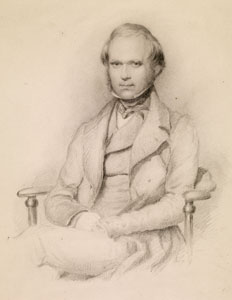'I hope my wanderings will not unfit me for a quiet life'
 |
|---|
| Portrait of Charles Darwin in 1839, by George Richmond. CUL. |
It is ‘a most comfortable reflection…that a ship, being made of wood & iron, cannot last for ever & therefore this voyage must have an end.’ After spells ashore in Australia and Africa, and a detour back across the Atlantic to check the very first charts they had made of South America, the Beagle arrived in Falmouth on 2 October 1836 after a voyage of four years, nine months and six days. Darwin, now twenty-six, wrote wearily: ‘I am convinced it is a most ridiculous thing to go round the world, when by staying quietly the world will go round with you’. His notes and diaries furnished material for an impressive array of publications, including a best-selling travel book, Journal of Researches, and, in private notebooks begun in the months immediately after the voyage, Darwin began to crystallise the ideas only finally made public more than twenty years later in On the Origin of Species.

